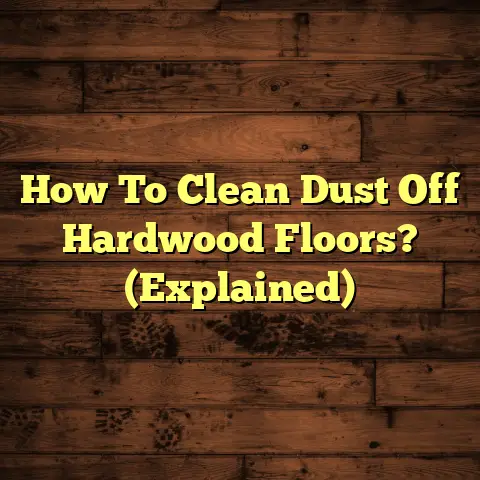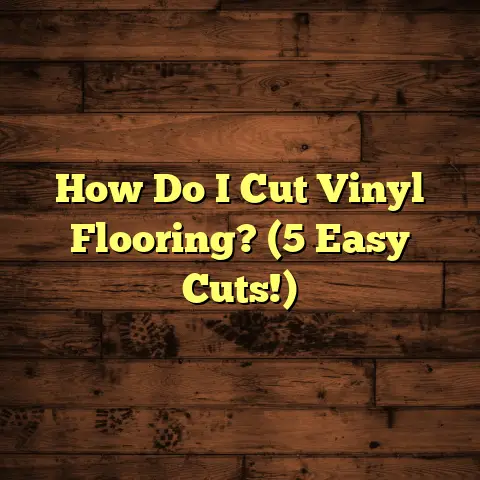Glue Down Removal Costs? (1 Day Quote Needed!)
Imagine walking into a room, and instead
of being greeted by tired, dated flooring,
you’re met with a space brimming with
potential.
The light dances across a
newly exposed subfloor, ready for a fresh
start.
That’s the power of removing
glue down flooring.
I’ve seen it time and time again.
Homeowners
are amazed at how much bigger and brighter
their rooms feel after getting rid of that
old, stuck-down flooring.
It’s not just
about aesthetics, though.
It’s about
creating a foundation for a home that
truly reflects your style and needs.
Flooring is more than just something you
walk on.
It sets the tone for your entire
home.
It impacts everything from the
ambiance to the functionality of a space.
That’s why understanding the process and
costs associated with glue down flooring
removal is so important.
It’s an investment
in your home’s future.
So, let’s dive in and explore the ins and
outs of glue down flooring removal.
I’ll
walk you through everything you need to
know, from the basics of what it is to
how to get a quote in just one day!
Section 1: The Basics of
Glue Down Flooring
Okay, so what exactly is glue down
flooring?
Simply put, it’s any type of
flooring that’s directly adhered to the
subfloor using a strong adhesive.
We’re
talking materials like:
- Vinyl: Think luxury vinyl planks (LVP)
or tiles (LVT).
These are super popular
because they’re durable and waterproof. - Hardwood: Yes, even hardwood can be
glued down!
Usually, it’s thinner planks
or engineered hardwood. - Laminate: Similar to hardwood, laminate
offers a wood-like look at a lower price
point and can be glued down.
Why Glue Down?
The installation process is fairly
straightforward.
The subfloor needs to be
clean, level, and dry.
Then, the adhesive
is applied, and the flooring is carefully
laid down and pressed into place.
Homeowners often choose this method for a few key reasons:
- Stability: Glue down flooring is incredibly
stable.
It doesn’t shift or move, even
in high-traffic areas. - Moisture Resistance: When properly
installed with the right adhesive, it can
offer better moisture resistance compared
to floating floors. - Direct Contact: It provides a more
solid feel underfoot, as there’s no
air gap between the flooring and the
subfloor.
The Flip Side:
But, like anything, there are drawbacks:
- Removal is a Pain: As you’ll soon
discover, removing glue down flooring
is no walk in the park.
The adhesive
creates a strong bond that can be tough
to break. - Subfloor Prep is Key: Any imperfections
in the subfloor will telegraph through
the flooring.
So, extensive prep work
is often required. - Adhesive Concerns: Some adhesives can
release VOCs (volatile organic compounds),
which can affect indoor air quality.
Understanding these pros and cons is crucial when deciding whether to install glue down flooring in the first place, and it provides context for why removal might be necessary down the line.
Section 2: Why Remove
Glue Down Flooring?
Let’s be real, nobody wakes up one morning
and wants to remove their glue down
flooring.
There’s usually a good reason
behind it.
I’ve seen it all in my years
as a flooring contractor.
Here are some
of the most common culprits:
- Damage: Water damage, scratches, dents,
and stains can all take their toll.
Especially with vinyl, once it’s damaged,
it’s hard to repair. - Outdated Styles: Let’s face it, flooring
trends change.
That avocado green vinyl
might have been all the rage in the ’70s,
but it’s probably not doing you any
favors now. - Desire for New Materials: Maybe you’re
tired of vinyl and want to upgrade to
hardwood or tile.
Or perhaps you’re
looking for something more eco-friendly
like bamboo or cork. - Home Renovation Project: A new kitchen
or bathroom often means new flooring.
And if you’re changing the layout, you’ll
likely need to remove the old flooring
to ensure a seamless transition.
I remember one homeowner, Sarah, who had
inherited her grandmother’s house.
The
house was lovely, but the kitchen had
this awful orange linoleum flooring that
was glued down.
It was peeling, cracked,
and just plain ugly.
“I couldn’t stand it anymore!” she told me.
“It made the whole kitchen feel depressing.”
We removed the old linoleum, prepped the
subfloor, and installed beautiful new
ceramic tile.
The transformation was
incredible.
Sarah was so happy; she said
it felt like she had a brand new house.
That’s the power of a flooring makeover.
It can completely transform a space and
your emotional connection to it.
Boosting Property Value:
And let’s not forget the potential increase
in property value.
Upgrading your flooring
is one of the best ways to boost your
home’s appeal and marketability.
According
to a recent report by Zillow, homes with
updated flooring sell for an average of
\$2,000 – \$5,000 more than comparable
homes with outdated flooring.
Think about it: when potential buyers walk
into your home, the flooring is one of
the first things they notice.
Fresh,
modern flooring can create a positive
first impression and make your home stand
out from the competition.
Section 3: The Removal Process
Alright, let’s get down to the nitty-gritty.
What does the glue down flooring removal
process actually look like?
It’s not pretty, trust me.
But with the
right tools and techniques, it can be done.
Here’s a step-by-step overview:
Preparation:
- Clear the Room: Remove all furniture,
appliances, and anything else that’s
in the way. - Protect Yourself: Wear safety glasses,
gloves, and a dust mask.
This is a
dirty job! - Ventilate the Area: Open windows and
doors to provide plenty of ventilation.
This is especially important if you’re
dealing with old adhesives that may
contain VOCs.
- Clear the Room: Remove all furniture,
Breaking the Bond:
- Scoring the Flooring: Use a utility
knife to score the flooring into smaller
sections.
This makes it easier to pry
up. - Heat Gun or Hair Dryer: Applying heat
can help soften the adhesive.
Use a
heat gun or hair dryer to warm up
sections of the flooring before you
start prying. - Prying Tools: This is where the
muscle comes in.
Use a floor scraper,
putty knife, or pry bar to lift the
flooring from the subfloor.
Be careful
not to damage the subfloor in the
process.
- Scoring the Flooring: Use a utility
Adhesive Removal:
- Scraping: Once the flooring is removed,
you’ll likely be left with a layer of
adhesive residue.
Use a floor scraper
or adhesive remover to get rid of it. - Chemical Solvents: For stubborn
adhesive, you may need to use a chemical
solvent.
Be sure to follow the
manufacturer’s instructions carefully
and wear appropriate safety gear. - Grinding: In some cases, you may
need to grind down the subfloor to
remove the adhesive.
This requires
specialized equipment and should be
done by a professional.
- Scraping: Once the flooring is removed,
-
Subfloor Repair:
- Inspect the Subfloor: Once the adhesive
is removed, inspect the subfloor for
any damage. - Patching and Leveling: Fill any holes
or cracks with a patching compound and
level the subfloor as needed. - Sanding: Sand the subfloor to create
a smooth, even surface for the new
flooring.
- Inspect the Subfloor: Once the adhesive
Disposal:
- Proper Disposal: Dispose of the old
flooring and adhesive properly.
Check
with your local waste management
company for guidelines on disposal.
- Proper Disposal: Dispose of the old
Tools of the Trade:
Here’s a list of tools and equipment you’ll typically need:
- Utility knife
- Heat gun or hair dryer
- Floor scraper
- Putty knife
- Pry bar
- Adhesive remover
- Chemical solvents (if needed)
- Floor grinder (if needed)
- Patching compound
- Sanding equipment
- Safety glasses
- Gloves
- Dust mask
Time Commitment:
The time required for removal can vary greatly depending on several factors:
- Size of the Area: Obviously, a small
bathroom will take less time than a
large living room. - Type of Glue: Some adhesives are stronger
and more difficult to remove than others. - Type of Flooring: Thicker flooring like
hardwood will generally take longer to
remove than thinner flooring like vinyl. - Your Experience: If you’re a seasoned
DIYer, you’ll likely be faster than
someone who’s never done it before.
As a general rule, you can expect it to take anywhere from a few hours to a few days to remove glue down flooring from a single room.
Section 4: Cost Breakdown of
Glue Down Removal
Now, let’s talk money. How much is this whole process going to cost you?
The cost of glue down flooring removal can vary widely depending on several factors, including:
- Location: Labor costs vary from region
to region. - Complexity of the Job: A simple removal
will cost less than a complex one that
requires extensive subfloor repair. - Contractor Rates: Different contractors
charge different rates.
Here’s a breakdown of the typical costs involved:
Labor Costs:
- Average rates for professional removal
range from \$3 to \$8 per square foot.
This includes the cost of removing
the old flooring, scraping the adhesive,
and preparing the subfloor for new
flooring. - Some contractors may charge an hourly
rate instead of a per-square-foot
rate.
Hourly rates typically range
from \$50 to \$100 per hour.
- Average rates for professional removal
-
Equipment Rental Fees:
- If you’re doing it yourself, you may
need to rent some equipment, such as
a floor scraper, floor grinder, or
adhesive remover. - Rental fees can range from \$50 to \$200
per day, depending on the equipment.
- If you’re doing it yourself, you may
-
Disposal Fees:
- You’ll need to dispose of the old
flooring and adhesive properly. - Disposal fees can range from \$50 to \$200,
depending on the amount of material
and your local waste management company’s
rates.
- You’ll need to dispose of the old
Potential Hidden Costs:
- Subfloor Repair: This is the big one.
If the subfloor is damaged, you’ll
need to repair it before installing
new flooring.
This can add significant
costs to the project. - Additional Materials: You may need
to purchase additional materials such
as patching compound, leveling compound,
or adhesive remover.
- Subfloor Repair: This is the big one.
Professional vs. DIY:
So, should you hire a professional or tackle this project yourself? Here’s a comparison:
DIY is tempting, but be realistic about
your skills and the amount of time you have
available.
If you’re not comfortable with
the physical demands of the job or if you’re
concerned about damaging the subfloor, it’s
best to hire a professional.
Example Cost Scenarios:
Let’s look at a couple of hypothetical scenarios to give you a better idea of the potential costs:
-
Small Bathroom (50 sq ft):
- Professional Removal: \$150 – \$400
- DIY Removal: \$50 – \$150 (plus your
time and effort)
-
Large Living Room (300 sq ft):
- Professional Removal: \$900 – \$2400
- DIY Removal: \$200 – \$500 (plus your
time and effort)
These are just estimates, of course.
The
actual cost will depend on the specific
factors mentioned above.
Section 5: Getting a Quote in
One Day
Okay, so you’re thinking about hiring a
professional.
How do you get a quote and
how can you get it quickly?
Getting a quote for glue down flooring
removal is usually a straightforward
process.
Here’s what you can expect:
Contact Local Contractors:
- Start by searching online for flooring
contractors in your area.
Check online
review sites like Yelp, Google Reviews,
and Angie’s List to find reputable
contractors. - Ask friends, family, and neighbors for
recommendations.
- Start by searching online for flooring
-
Request a Quote:
- Contact several contractors and request
a quote for glue down flooring removal. - Be sure to provide them with as much
information as possible about the project,
including the size of the area, the type
of flooring, and the condition of the
subfloor.
- Contact several contractors and request
-
Schedule an On-Site Estimate:
- Most contractors will want to come to
your home to assess the project in
person before providing a quote. - This allows them to get a better understanding
of the scope of the work and identify
any potential challenges.
- Most contractors will want to come to
-
Review the Quote:
- Once the contractor has assessed the
project, they’ll provide you with
a written quote. - Review the quote carefully to make sure
it includes all of the costs involved,
including labor, equipment rental,
disposal fees, and potential hidden
costs.
- Once the contractor has assessed the
Preparing for the Quote:
To speed up the process and ensure an accurate quote, here’s what you can do:
- Measure the Area: Use a measuring tape
to determine the square footage of the
area where you want to remove the flooring. - Assess the Condition of the Flooring:
Note any damage, such as cracks, stains,
or water damage. - Take Photos: Take photos of the flooring
and the subfloor.
This can help the
contractor get a better understanding
of the project before they come to your
home.
Factors Affecting Quote Speed:
- Local Market Conditions: In some areas,
there may be a high demand for flooring
contractors, which can make it difficult
to get a quote quickly. - Contractor Availability: Contractors
are often booked weeks or even months
in advance. - Complexity of the Job: A complex job
may require more time to assess and
quote.
Tips for Getting a Quote in One Day:
- Call Early: Contact contractors early
in the morning to increase your chances
of getting a same-day appointment. - Be Flexible: Be willing to adjust your
schedule to accommodate the contractor’s
availability. - Provide All Necessary Information: The
more information you can provide upfront,
the faster the contractor can prepare
a quote.
Section 6: Real-Life Examples
and Case Studies
Let’s take a look at some real-life examples of homeowners who have removed glue down flooring and the costs they incurred:
Case Study 1: The Water-Damaged Kitchen
- Homeowner: John S.
- Location: Chicago, IL
- Problem: Water damage to glue down
vinyl flooring in the kitchen. - Solution: Hired a professional to
remove the old flooring, repair the
subfloor, and install new tile flooring. - Cost:
- Removal: \$500
- Subfloor Repair: \$300
- New Tile Installation: \$1500
- Total: \$2300
- Outcome: John was thrilled with the
new tile flooring and the peace of mind
knowing that the water damage had been
properly addressed.
Case Study 2: The Outdated Living Room
- Homeowner: Mary L.
- Location: Austin, TX
- Problem: Outdated glue down laminate
flooring in the living room. - Solution: DIY removal of the old
flooring, followed by professional
installation of new hardwood flooring. - Cost:
- DIY Removal: \$100 (for tools and supplies)
- New Hardwood Installation: \$3000
- Total: \$3100
- Outcome: Mary was happy with the
new hardwood flooring and the updated
look of her living room.
She saved money
by doing the removal herself, but it
took her an entire weekend.
Case Study 3: The Home Renovation Project
- Homeowner: David K.
- Location: Los Angeles, CA
- Problem: Glue down vinyl flooring in
the bathroom needed to be removed as
part of a larger home renovation project. - Solution: Hired a general contractor
to handle the entire renovation, including
flooring removal and installation. - Cost: (Flooring removal and installation
were included in the overall renovation
cost, which was \$10,000) - Outcome: David was pleased with the
seamless integration of the flooring
removal into the larger renovation project.
Before-and-After Photos:
(Imagine a series of before-and-after photos here, showcasing the transformations in each of the case studies.)
Conclusion
Removing glue down flooring can seem like
a daunting task, but it’s an investment
that can pay off in the long run.
Whether
you’re dealing with damage, outdated styles,
or simply a desire for something new,
removing old flooring can transform your
space and improve your home’s value.
Remember, the key to a successful flooring transformation is to carefully consider your options, weigh the pros and cons of DIY versus professional removal, and get multiple quotes to ensure you’re getting a fair price.
Don’t let that old, stuck-down flooring
hold you back any longer.
Take the first
step toward your flooring transformation
today!





